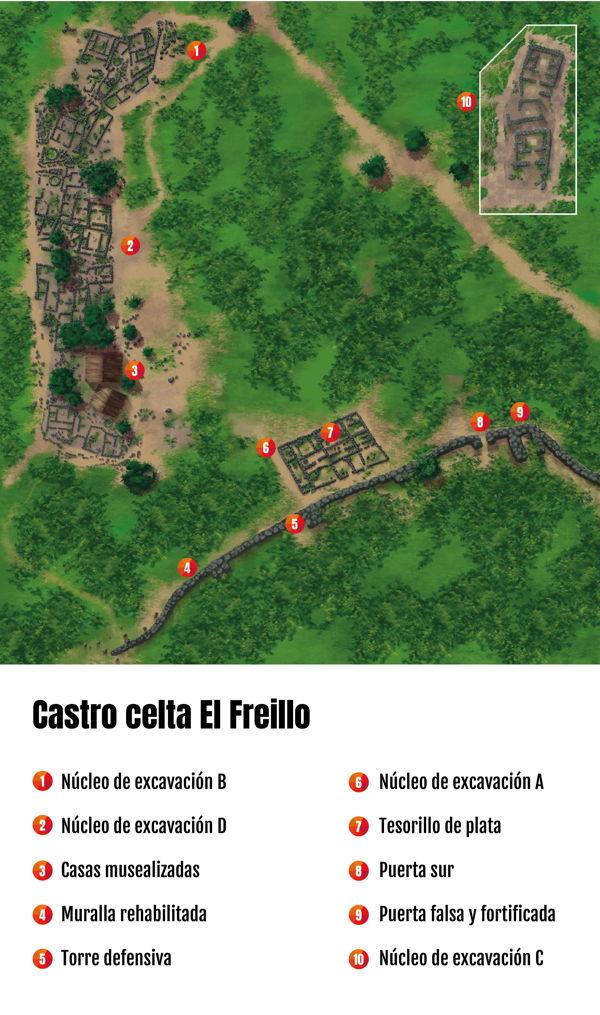ARQUEOLOGICAL ZONE OF EL RASO

On the left margin of the garganta de Alardos, from Gredos to the Tiétar river, there are a series of sites that bear traces of human activity since at least the third millennium B.C.
This is where the life of our ancestors has developed. It is a space facing south and protected from the cold north winds, with abundant water, and where the different botanical levels have allowed all kinds of activities to its inhabitants: livestock, agriculture, fruit and berry picking and forestry.
This explains the number of archaeological remains that the Town Council of Candeleda is currently endeavouring to make accessible to visitors. The cave paintings of Peña Escrita, the Prao de la Carrera hillfort, the open settlement of Castañar, the necropolis of Las Guijas, the hillfort of El Raso and the hillfort of Castrejón, the Vetton sanctuary of Vaelico, Christianised in the Visigothic period with the dedication of San Juan and whose rituals have survived... all of this is summarised in the Archaeological Museum of El Raso.
And, as if that were not enough, archaeological sites nestled in the foothills of Gredos, in one of the amazing landscapes that allows us to combine the knowledge of history with the enjoyment of nature.
(*) It should be mentioned that the Candeleda Town Council is currently progressing in the excavations and in the rebuilding of the hillfort in order to continue extending the visit area.
PEÑA ESCRITA
Before writing, the communication of ideas was done using graphic signs that were understood by the groups that inhabited a large territory. Rock shelters, caves and important crags were the chosen places: this shelter was one of them.
These paintings stylistically belong to the so-called "Arte Esquemático" (Schematic Art), which is developed between the Neolithic and the Bronze Age (4.000-1 000 B.C.), and they were made using ochre (iron ore), mixed with other substances.
It is very probably that the different figures date from different times, even from very distant from each other, and for that reason their message in each time was different.
EL PRAO DE LA CARRERA
It is a fortified hillfort from the Bronze Age testifies to the existence of the first indigenous settlers of Gredos around 2.300 B.C.
After the excavations carried out, remains of huts built with wooden posts were found. Also were found remains of handmade pottery, including pieces of pots, bowls and storage pottery; some of them were decorated with incised motifs. Another important element of this excavation was the delimitation of the first defensive wall of the castro, which is 3,5 metres wide and at least 200 metres long.
EL CASTRO DE EL RASO
It is considered to be one of the most important Vetton sites in the centre of the Iberian Peninsula. Successive archaeological excavation campaigns have uncovered part of its houses, which were later reinforced and, in some cases, rebuilt.
.jpg)
It also stands out for its powerful defensive system - walls, towers, moats... - that surround its more than twenty hectares in a perimeter of almost two thousand metres, which are in the process of being restored.
The Vettones built this castro after Hannibal's devastating incursion into these lands. And between the 3rd and 1st centuries B.C. it was inhabited by a population of more than 2.000 people. In Caesar's time, the Romans forced its inhabitants to abandon it.
.jpg)
Guided tours of the hillfort provide a better idea of the site and the historical period in which the Vettones lived there. The visit can also be made on your own, following a set of renewed signs that allow you to get a closer look at the historical and cultural reality of the settlement.
.jpg)
LA MAJADA DE BRAGUILLAS (etnographical area)
The Majada de Braguillas (a majada is a kind of sheep pen) is an illustrative example of the harshness of the traditional life of the goatherds on the south side of Gredos. They lived in sheepfolds, subsisting on the production of the vegetable garden and the annual slaughter of the pigs, and earning money by selling goat's cheese and goats.
This traditional way of grazing has remained unchanged until barely three decades ago. Only a small group of goatherds live today in the sierra, where the ruins of the sheepfolds that were once active are now archaeological remains.
NATIONAL ARQUELOGICAL MUSEUM
With original pieces from the excavations of the rich archaeological heritage of the area, the Municipal Archaeological Museum of El Raso, which is a member of the Network of Museums of Castilla y León, takes you on a visual journey from the Bronze Age to the Christianisation of the Vetton sanctuary of Postoloboso, through the knowledge of two forts, cave paintings, a necropolis and a sanctuary.



